Discover Florida Nature
It's time to explore the natural Florida


|
|
|
|
|
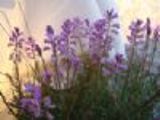 Lewton's
Polygala (Polygala lewtonii)-Lewton’s polygala occurs in Ocala
National Forest, on the Mount Dora Ridge in Marion County, and on the
Lake Wales Ridge in Lake, Osceola, Orange, Polk and Highlands
Counties, Florida. Lewton’s polygala occurs on yellow sands in sandhill,
turkey oak sandhill and oak-hickory scrub. Lewton’s polygala is a
short-lived perennial that grows to 20 cm in height. Plants produce
multiple stems from a central root crown. Stems may be prostrate,
ascending or erect. Lewton’s polygala has three kinds of flowers. The
fruit is a capsule containing two seeds. Each seed has a fleshy
appendage that attracts ants and is believed to aid in seed dispersal. Lewton's
Polygala (Polygala lewtonii)-Lewton’s polygala occurs in Ocala
National Forest, on the Mount Dora Ridge in Marion County, and on the
Lake Wales Ridge in Lake, Osceola, Orange, Polk and Highlands
Counties, Florida. Lewton’s polygala occurs on yellow sands in sandhill,
turkey oak sandhill and oak-hickory scrub. Lewton’s polygala is a
short-lived perennial that grows to 20 cm in height. Plants produce
multiple stems from a central root crown. Stems may be prostrate,
ascending or erect. Lewton’s polygala has three kinds of flowers. The
fruit is a capsule containing two seeds. Each seed has a fleshy
appendage that attracts ants and is believed to aid in seed dispersal. 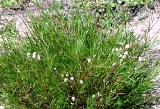 Wireweed
(Polygonella basiramia)- Polygonella basiramia is an herbaceous
perennial endemic to the central ridges of the Florida peninsula.
Wireweed have remarkably diverse growth habits ranging from tall and
leafy, to upright and virtually leafless. The Stems and leaves of the
wireweed plant range in color from green to dark red; red coloration in
the stems and leaves appears to be associated with individuals more
exposed to sunlight and with older vegetative parts, although even
seedlings are often red. Individual wireweed flowers are small, white to
slightly pink with 5 sepals (no petals), pink pistils, and black
anthers. Wireweed is most commonly found in rosemary scrub, also known
as rosemary phase of sand pine scrub. Wireweed is endemic to the Lake
Wales, Winter Haven, and Bombing Range ridges in central peninsular
Florida. It ranges from Lake Pierce in Polk County southward to Venus
near the southern tip of the Lake Wales Ridge in Highlands County Wireweed
(Polygonella basiramia)- Polygonella basiramia is an herbaceous
perennial endemic to the central ridges of the Florida peninsula.
Wireweed have remarkably diverse growth habits ranging from tall and
leafy, to upright and virtually leafless. The Stems and leaves of the
wireweed plant range in color from green to dark red; red coloration in
the stems and leaves appears to be associated with individuals more
exposed to sunlight and with older vegetative parts, although even
seedlings are often red. Individual wireweed flowers are small, white to
slightly pink with 5 sepals (no petals), pink pistils, and black
anthers. Wireweed is most commonly found in rosemary scrub, also known
as rosemary phase of sand pine scrub. Wireweed is endemic to the Lake
Wales, Winter Haven, and Bombing Range ridges in central peninsular
Florida. It ranges from Lake Pierce in Polk County southward to Venus
near the southern tip of the Lake Wales Ridge in Highlands County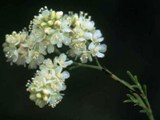 Sandlace
(Polygonella myriophylla)- Sandlace occurs naturally only in scrubs on
the Lake Wales Ridge in Orange, Polk and Highlands Counties. Look for it
in vacant lots and road shoulders within 10 miles of US-27 in Polk and
Highlands Counties. If you see this plant you know you are in true Lake
Wales Ridge scrub. This sprawling evergreen shrub with needle-like
leaves looks a lot like the common landscaping groundcover, creeping
juniper. Sandlace's many branches zigzag along the ground and root at
the nodes, forming mats. Sandlace produces small white or cream colored
flowers and has small needle like leaves. Sandlace
(Polygonella myriophylla)- Sandlace occurs naturally only in scrubs on
the Lake Wales Ridge in Orange, Polk and Highlands Counties. Look for it
in vacant lots and road shoulders within 10 miles of US-27 in Polk and
Highlands Counties. If you see this plant you know you are in true Lake
Wales Ridge scrub. This sprawling evergreen shrub with needle-like
leaves looks a lot like the common landscaping groundcover, creeping
juniper. Sandlace's many branches zigzag along the ground and root at
the nodes, forming mats. Sandlace produces small white or cream colored
flowers and has small needle like leaves.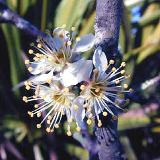 Scrub
plum (Prunus geniculata)- The scrub plum is a woody shrub
restricted to xeric upland habitats on the Lake Wales Ridge in
Highlands, Polk, Lake, Osceola, and Orange Counties. Scrub plum is very
drought tolerant, with small leaves that conserve water and a fibrous
root system that can extract moisture from the well-drained soils. It
has a low rounded form, generally growing to 3 to 4 feet tall. Its trunk
is gnarled, and partly buried in sand. Older plants are distinguished by
graying bark covered with lichens. In February and March, delicate white
flowers with yellow stamens sprout from skeletal branches. Fine toothed
leaves develop later, after the scrub plums have begun to set fruit. The
miniature plums develop in April and May, ripening to a soft reddish
purple. Scrub
plum (Prunus geniculata)- The scrub plum is a woody shrub
restricted to xeric upland habitats on the Lake Wales Ridge in
Highlands, Polk, Lake, Osceola, and Orange Counties. Scrub plum is very
drought tolerant, with small leaves that conserve water and a fibrous
root system that can extract moisture from the well-drained soils. It
has a low rounded form, generally growing to 3 to 4 feet tall. Its trunk
is gnarled, and partly buried in sand. Older plants are distinguished by
graying bark covered with lichens. In February and March, delicate white
flowers with yellow stamens sprout from skeletal branches. Fine toothed
leaves develop later, after the scrub plums have begun to set fruit. The
miniature plums develop in April and May, ripening to a soft reddish
purple.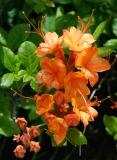 Chapman's
Rhododendron (Rhododendron chapmanii) Florida's native azaleas
include Flame azalea, an Endangered Species which blooms bright orange
and is very early flowering. Color variations and natural hybridization
makes positive identification difficult. Found in moist wooded hammocks,
the wild azalea can reach a height of six feet. The blooms of the wild
azalea come in a variety of colors, including pinks and whites. Wild
azaleas bloom in late march and April and attract a variety of
butterflies, along with attracting hummingbirds. Chapman's
Rhododendron (Rhododendron chapmanii) Florida's native azaleas
include Flame azalea, an Endangered Species which blooms bright orange
and is very early flowering. Color variations and natural hybridization
makes positive identification difficult. Found in moist wooded hammocks,
the wild azalea can reach a height of six feet. The blooms of the wild
azalea come in a variety of colors, including pinks and whites. Wild
azaleas bloom in late march and April and attract a variety of
butterflies, along with attracting hummingbirds.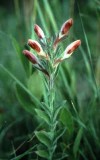 American
Chaffseed (Schwalbea americana)-American chaffseed is an
erect perennial herb with unbranched stems (or stems branched only at
the base) with large, purplish-yellow, tubular flowers that are borne
singly on short stalks in the axils of the uppermost, reduced leaves
(bracts). The leaves are alternate, lance-shaped to elliptic, stalkless,
1 to 2 inches long, and entire. The entire plant is densely, but
minutely hairy throughout, including the flowers. American chaffseed
occurs in sandy, acidic, seasonally moist to dry soils. It is generally
found in habitats described as open, moist pine flatwood. American
Chaffseed (Schwalbea americana)-American chaffseed is an
erect perennial herb with unbranched stems (or stems branched only at
the base) with large, purplish-yellow, tubular flowers that are borne
singly on short stalks in the axils of the uppermost, reduced leaves
(bracts). The leaves are alternate, lance-shaped to elliptic, stalkless,
1 to 2 inches long, and entire. The entire plant is densely, but
minutely hairy throughout, including the flowers. American chaffseed
occurs in sandy, acidic, seasonally moist to dry soils. It is generally
found in habitats described as open, moist pine flatwood.
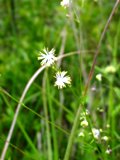 Cooley's
Meadowrue (Thalictrum cooleyi)- Cooley's meadow-rue is a
perennial herb originating from an underground rhizome. In shaded
conditions, it grows with lax stems often leaning against other plants
or may trail along the ground, but under ideal conditions, in full sun,
these stems are erect. Cooley's meadow-rue grows up to 12 to 48 inches
in height, but may grow as high as 6 feet on recently burned sites.
Cooley's meadow-rue has narrower leaflets with fewer lobes than any
other Thalictrum. Its stem and basal leaves are highly variable both in
shape and size. Cooley's meadow-rue is an endemic of the southeastern
Coastal Plain from Florida to North Carolina. Cooley's meadow-rue
inhabits sunny, moist places such as open, savanna-like forest edges and
clearings. The species is found along utility and highway rights-of-way
in former savanna habitats. Cooley's
Meadowrue (Thalictrum cooleyi)- Cooley's meadow-rue is a
perennial herb originating from an underground rhizome. In shaded
conditions, it grows with lax stems often leaning against other plants
or may trail along the ground, but under ideal conditions, in full sun,
these stems are erect. Cooley's meadow-rue grows up to 12 to 48 inches
in height, but may grow as high as 6 feet on recently burned sites.
Cooley's meadow-rue has narrower leaflets with fewer lobes than any
other Thalictrum. Its stem and basal leaves are highly variable both in
shape and size. Cooley's meadow-rue is an endemic of the southeastern
Coastal Plain from Florida to North Carolina. Cooley's meadow-rue
inhabits sunny, moist places such as open, savanna-like forest edges and
clearings. The species is found along utility and highway rights-of-way
in former savanna habitats. 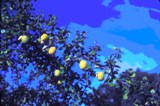 Scrub
Ziziphus (Ziziphus celata)-Florida Jujube or Scrub Ziziphus is
native and endemic to the Lake Wales Ridge scrub habitat of central
Florida in Polk and Highlands counties. It is a shrub to small or
medium-sized tree with small, rounded leaves and orange fruits
(jujubes). The branches all have sharp, distinctive thorns. Sadly, this
interesting and endemic native plant is listed as endangered by the U.S.
and state of Florida due to habitat destruction of the remaining and
rare scrub habitat it is found in, which is also almost entirely endemic
to Florida. It is suitable for xeriscaping in a native plant garden;
however, permits are needed to obtain seeds. Florida ziziphus, one of
the rarest plants in Florida, has been transplanted onto the Carter
Creek unit of the Lake Wales Ridge National Wildlife Refuge. Scrub
Ziziphus (Ziziphus celata)-Florida Jujube or Scrub Ziziphus is
native and endemic to the Lake Wales Ridge scrub habitat of central
Florida in Polk and Highlands counties. It is a shrub to small or
medium-sized tree with small, rounded leaves and orange fruits
(jujubes). The branches all have sharp, distinctive thorns. Sadly, this
interesting and endemic native plant is listed as endangered by the U.S.
and state of Florida due to habitat destruction of the remaining and
rare scrub habitat it is found in, which is also almost entirely endemic
to Florida. It is suitable for xeriscaping in a native plant garden;
however, permits are needed to obtain seeds. Florida ziziphus, one of
the rarest plants in Florida, has been transplanted onto the Carter
Creek unit of the Lake Wales Ridge National Wildlife Refuge. |
|
|
Advertise | Privacy Statement | Dog Encyclopedia | Video |Contact | Alaska Nature |
|